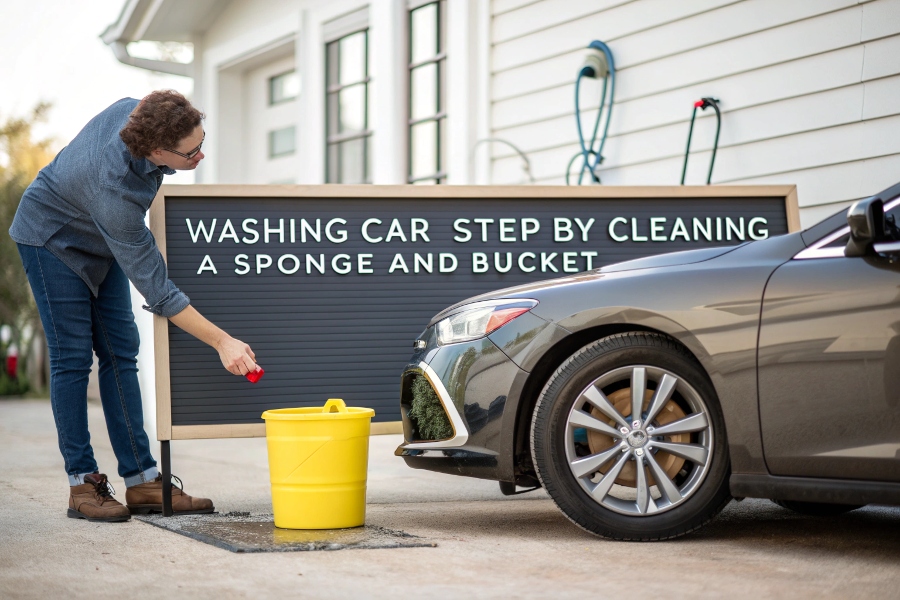Washing your car properly is more than just a quick rinse with a hose—it is about maintaining its shine, protecting the paint, and preventing long-term damage. A well-washed car not only looks great but also retains its value over time.
If you have been making common car washing mistakes, this guide will walk you through the best techniques to clean your vehicle like a pro.
What You’ll Need:
Before starting, gather the following items:
✔ Two buckets (one for clean water, one for rinsing)
✔ pH-balanced car shampoo
✔ Microfiber wash mitt
✔ Soft-bristle wheel brush
✔ Tire cleaner
✔ Hose or pressure washer
✔ Microfiber drying towel
✔ Clay bar (optional)
✔ Car wax or sealant (optional)
Now, let’s go step by step.
Step 1: Park in a Shaded Area
Why It’s Important:
Washing your car in direct sunlight causes soap and water to dry too quickly, leading to water spots and streaks on the surface.
Pro Tip:
Always wash your car in the shade or during cooler parts of the day, like early morning or late afternoon.
Step 2: Start with the Wheels and Tires
Why It’s Important:
Your wheels collect the most dirt, brake dust, and grime. Cleaning them first prevents dirty water from splashing onto a freshly washed car.
How to Do It:
- Use a dedicated wheel brush and tire cleaner.
- Scrub each wheel thoroughly, reaching inside the rims.
- Rinse off the dirt before moving to the car’s body.
Step 3: Pre-Rinse Your Car
Why It’s Important:
Skipping the pre-rinse means rubbing dirt directly onto the paint, increasing the risk of swirl marks and scratches.
How to Do It:
- Use a hose or pressure washer to remove loose dirt and debris.
- Rinse from top to bottom, ensuring even coverage.
Step 4: Use the Two-Bucket Method
Why It’s Important:
Using just one bucket can spread dirt back onto your car, increasing the risk of scratches.
How to Do It:
- Fill one bucket with clean, soapy water and another with plain water.
- Dip your microfiber wash mitt into the soapy water, wash a section of the car, then rinse it in the clean water bucket before reloading with soap.
- Always wash from top to bottom to prevent dragging dirt onto cleaner areas.
Step 5: Wash in Sections
Why It’s Important:
Washing the entire car at once can cause soap to dry too quickly, leading to streaks.
How to Do It:
- Wash one section at a time (roof, windows, hood, doors, etc.).
- Rinse each section immediately after scrubbing to prevent soap residue from drying.
Step 6: Final Rinse with Low-Pressure Water
Why It’s Important:
Using high-pressure water at close range can push dirt into the paint, causing micro-abrasions.
How to Do It:
- Use a gentle flow of water to rinse off soap.
- Rinse from top to bottom for an even clean.
Step 7: Dry the Car Properly
Why It’s Important:
Allowing your car to air dry can lead to water spots, which are difficult to remove.
How to Do It:
- Use a soft microfiber drying towel instead of a regular towel to avoid scratches.
- Pat the surface dry instead of rubbing it.
- Use a silicone water blade for a streak-free finish.
Step 8: Use a Clay Bar for a Smooth Finish (Optional)
Why It’s Important:
Even after washing, some contaminants may remain on the paint surface, affecting the smoothness.
How to Do It:
- Gently rub a clay bar over the surface to remove remaining dirt.
- Keep the surface lubricated with a detailing spray to prevent scratches.
Step 9: Apply Car Wax or Sealant (Optional)
Why It’s Important:
Waxing adds a protective layer, enhancing shine and preventing damage from UV rays, rain, and road contaminants.
How to Do It:
- Use a high-quality car wax or paint sealant.
- Apply in small sections using a microfiber cloth.
- Buff off the wax once it dries for a glossy finish.
Step 10: Clean the Door Jambs and Undercarriage
Why It’s Important:
Neglecting door jambs and the undercarriage allows dirt, grime, and road salt to accumulate, leading to rust.
How to Do It:
- Wipe door jambs with a damp microfiber cloth.
- Use a hose or pressure washer to rinse the undercarriage.
How Often Should You Wash Your Car?
- For regular maintenance, wash your car every two weeks.
- If you live in a harsh environment (heavy rain, snow, or dust), wash it weekly.
- Apply wax or sealant every two to three months for added protection.
Final Thoughts
Washing your car the right way not only keeps it looking great but also protects its paint and value. By following this step-by-step guide, you can avoid common car washing mistakes and ensure your vehicle stays in top condition.
Key Takeaways:
- Always wash your car in the shade to prevent streaks.
- Clean the wheels first to prevent dirt from splashing onto a clean car.
- Use the two-bucket method and a microfiber wash mitt to avoid scratches.
- Dry your car with a microfiber towel instead of letting it air dry.
- Regular washing and occasional waxing help maintain the paint’s longevity.
By following these pro-level washing techniques, you can keep your car in showroom condition while protecting it from long-term damage.
